Still trying to improve my 100% whole grain baking. In this iteration I changed two things I believe needed to be addressed. I’ve lowered the hydration and reduced the final proof. I believe those changes have helped but still not quite where I want this to be, particularly the oven spring. Despite the dough coming out of the banneton and standing tall, there was still more spread during baking than I want to see. So it is still overproofed. As some more knowledgeable whole grain bakers have identified, red fife doesn’t seem to be very fermentation tolerant.
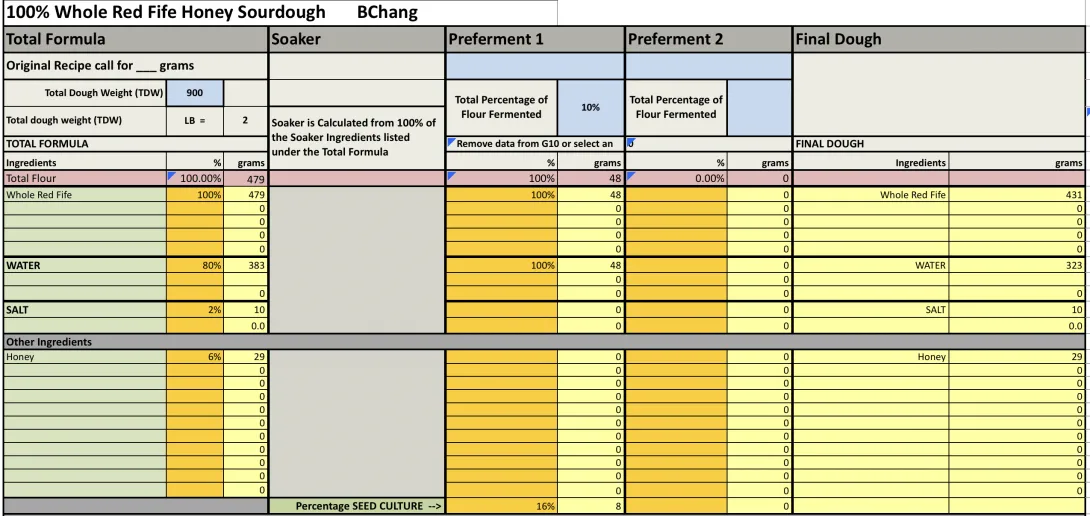
This time did a morning levain build 1:3:3 15 g + 47 g + 47 G
Morning saltolyse starting in fridge and then taking out before going to work.
Greatly reduced hydration from 86% to 80%
1220 pm bulk started levain added and in bowl Rubaud done
1250 pm 500 slap and folds completed with good gluten development
110 pm bench letterfold
140 pm lamination
210 pm coil fold
240 pm coil fold
310 pm coil fold
Shaped at 60% 445 pm
510 pm 75-80%
The dough was fermenting very rapidly, I wanted some bench time before cold retard, but barely caught it before it was almost at 80%.
I think I’ll need to shape when the aliquot jar shows 50% and start cold retard at 60-70% next time. I’m not sure that I need to reduce hydration more or not. I’ll have to look at the crumb later to assess.
Anyhow, better than my previous, but I really need to shape a bit earlier and cold retard sooner or bake after the bench rest without cold retard. 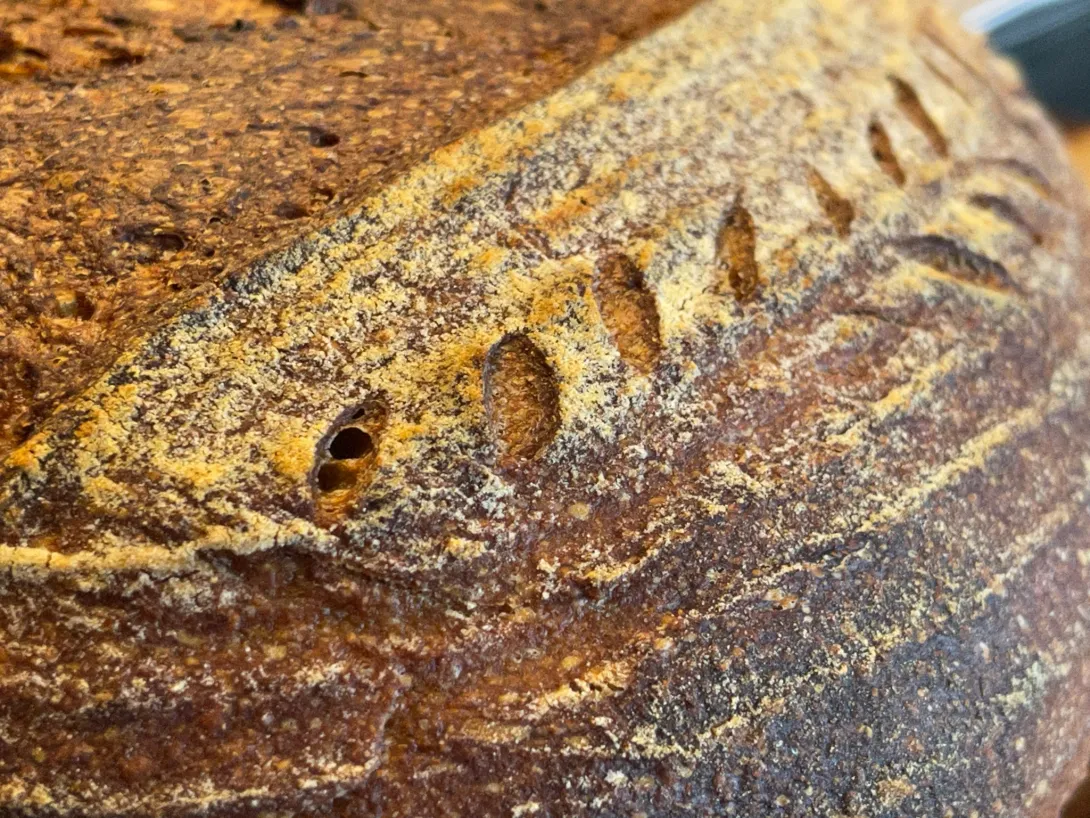
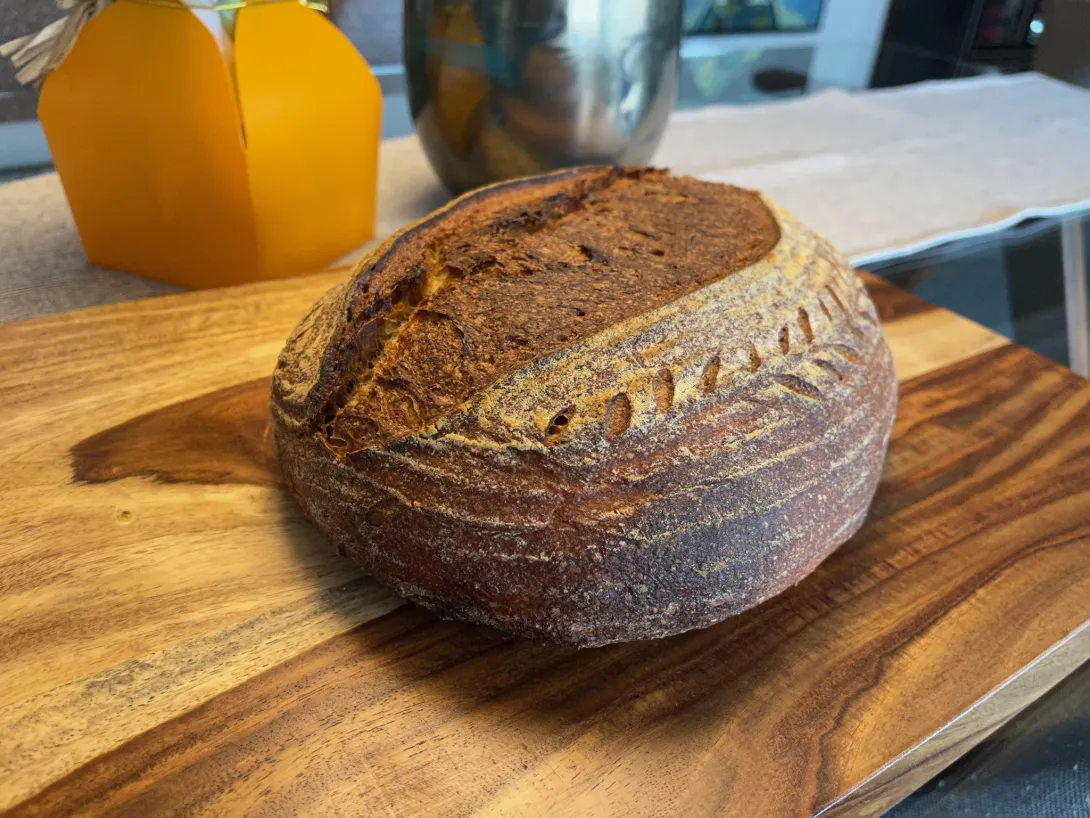
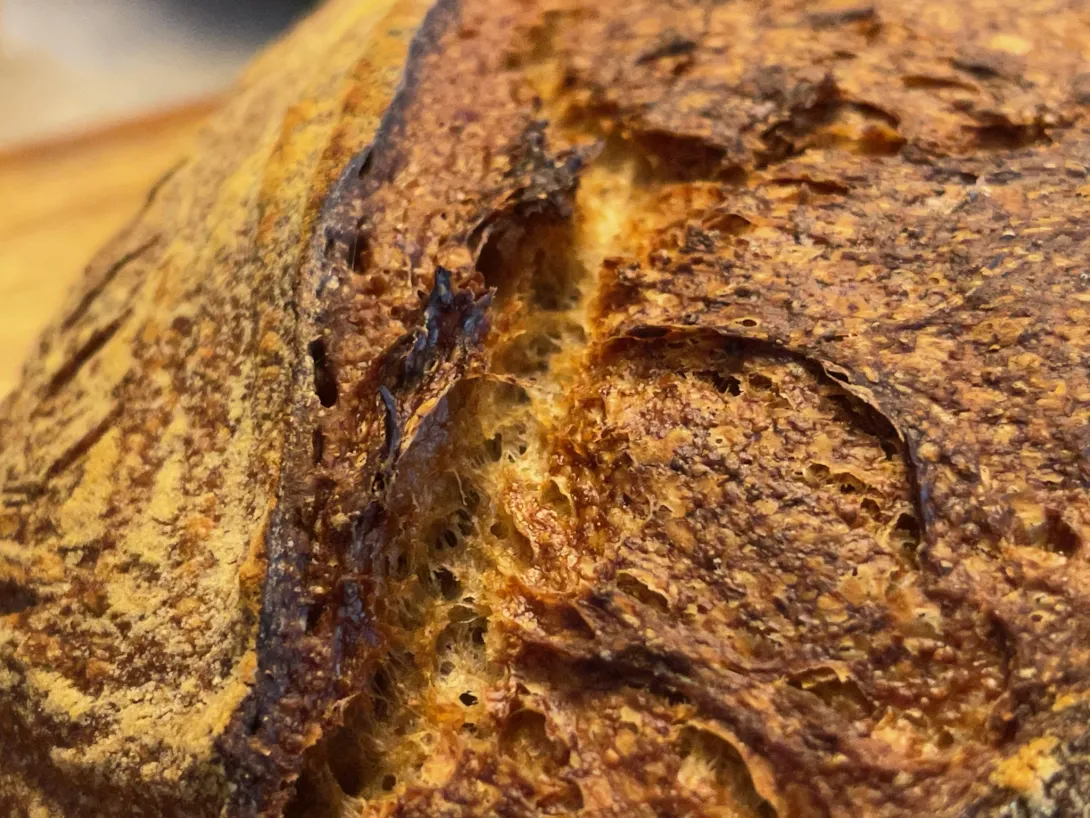
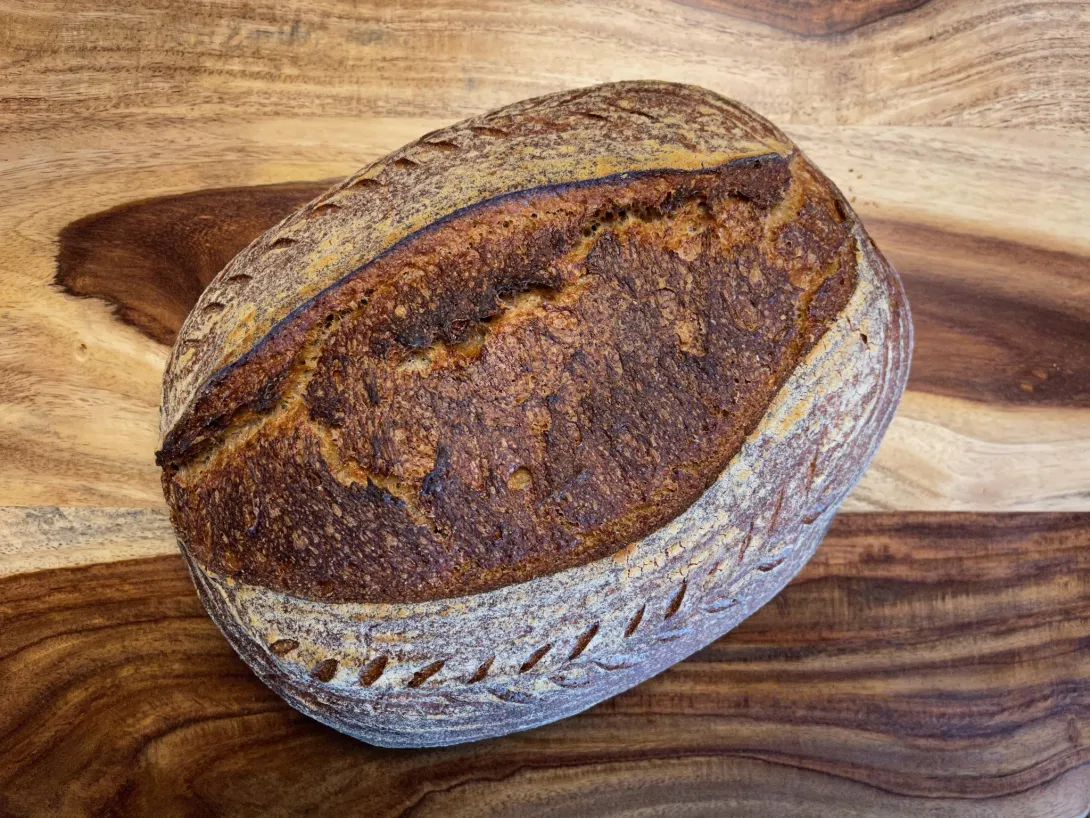
- Benito's Blog
- Log in or register to post comments
Definite signs of overproofing. I have to admit that I was planning on going to cold retard sooner than I did. The dough went into the fridge when the aliquot jar was between 75-80%, I was aiming for 70% but the dough was proofing really fast, much faster than I was expecting. Anyhow, the bread tastes good, so much better than that nasty whole wheat I baked with the last time I did a 100% wholegrain bread.
I’ll try this again and try to figure out what is ideal for this challenging flour. It is moving in the right direction in any event so that is good so I’m less disappointed with this bake.
Could it perhaps have been taller without scoring? Looks great regardless.
I suppose it is possible to have been taller without a score. I had high hopes for this one, it wasn’t sagging after scoring, but I am glad that it confirmed some things and is an improvement and I believe I know what to continue to change to fine tune it. Thanks.
Benny
Lovely crumb, I'm so glad you're feeling better about the direction this is headed!
Thank you mdw, that last loaf had a bad combination of looking sad and tasting terrible. Thus I was just really down on that bake. With this one, at least I can see which things to change I believe that will improve upon it.
Benny
Like I've said before it's like learning a new language. Everything is different but you're trying to say the same thing. It's a different dimension that is unfamiliar and uncomfortable, but that changes over time. The hands learn and adapt, and soon enough you become fluent. Of course there's no need for you to learn whole grain, especially if it's unrewarding, but it does bring me joy to see you progress! And I suspect you wouldn't keep trying if you weren't determined to succeed.
I hate giving up, so if the bread tastes good and I enjoy eating it, I’ll continue on most of the time. I’ll be back to this again reducing bulk and final proof.
Benny
Happy to read another installment of "benito and the red fife" with my morning coffee. So pleasing to see the arc of progress unfold, that crumb looks mighty good, but I'm more curious about the taste. If there were signs of overproofing were there any sour notes to the taste of it?
Reading this, I did wonder if bassinage would be applicable. The hydration of 80% looks to have been one of the sources of improvement, but my tinkering instinct, if it was me making it, would be to do all the dough strengthening at 75%, and by hand add the extra water in increments to increase to 80%. That would be me though!
In any case, looking forward to the next installment with great interest.
Glad you’re enjoying my trials and tribulations of whole grain baking Jon. It was so much easier with 20-25% bread flour added in.
I did not detect any significant sourness compared to my usual loaves. Keep in mind that wholegrains will buffer more acid than white flours can so I believe that you’ll taste overproofing more in overproofed low wholegrain breads more than wholegrain.
Although I wrote up the spreadsheet making it appear that I mixed at 80%, in fact I usually do a bassinage and mix at a lower percentage, usually 4-5% lower than written. Especially with this flour which doesn’t seem to be very thirsty, I started at 76% for the saltolyse and then after adding the levain it still felt a bit drier than I liked so increased it to 80% with two additions of water.
That looks like WW perfection to me.
With my loaves, I've only been able to go to 90% WW, and that is without a really good crumb.
I think my highest percent for a brag-worthy crumb was 75%.
You sir, have arrived.
Thank you Dave, that is kind of you to say. I don’t think I’m quite there yet, I still want to experiment with shortening bulk and final proof while keeping the overnight saltolyse. I still want to see if I can get a better profile on the loaf and get a better ear as well. I do think I have adjusted my expectations now for the crumb after several bakes.
Benny.. I think you should consider pushing forward the clock. Rather than getting this into the fridge at 5pm for a morning bake, get it into the fridge at 11pm for a morning bake. I think you'll get to where you'll want to be. The alternative is to not add the honey (or bring it down to 2% from 6) as that's speeding up the process too. Great looking loaf!
Frank thank you for sharing your thoughts on this. Reducing the honey is a simple enough thing to do, I hadn’t considered that. what do you think of going direct to bake and skipping the cold retard. My fridge is at a measured 3ºC do you think that it is overproofing in the fridge, it does take a while to cool down and could overproof in the fridge because of that. If I were to shape at 50% and then bake at 60% I wonder how that would turn out skipping cold retard completely or would that be too short?
Your fridge is cold enough. You have to optimize the variables : amount of starter; added sugar; temperature; time. You're currently (very slightly) over-proofing so you have to dial back one of those variables to find the edge of under vs over. I'd focus on one variable each bake. Time is the easiest one to play with. You'll know when you know as they say.. But really, you're being fussy as we bakers tend to be. You just baked a great loaf! :) Enjoy..
PS. You made a comment about using red fife as challenging.. I don't have much experience with that grain. What can you share? Thanks in advance!
It is likely that many grains are more challenging as a 100% whole grain bake. I’ve read now many times that other bakers have found this grain to be challenging. Marianna on this site has said as much as well saying that it isn’t very fermentation tolerant so you have to dial your fermentation back compared to what you might be able to with other flours. So it’s been challenging to me because lately I’ve been pushing fermentation forward so suddenly dealing with a flour that requires dialing back, waaaay back is a surprise I wasn’t expecting really.
All that being said, this grain being a Canadian heritage grain and one that I actually like eating at 100% it seems worth the efforts to figure it out. I’d also like to be able to say I can bake at 100% whole grain loaf successfully as well. : )
Benny
Benny, I'm glad to see this effort has been infused with new life via the recent CB. It is nice to see the progress and to observe cause and effect without having to do any of the work! Brown bread seems to be hot on TFL now. At some point, we'll have to make a common brown bread thread to tie all of these efforts (and conclusions) together. I'm going to try to source some Red Fife berries to join in on this and to help compare and contrast processes. For very fermentation intolerant flour, perhaps ascorbic acid would also be worth a try (recently documented in THIS POST). I've been wanting to try it, but don't currently have any unbuffered vitamin C.
Thank you, I am pleased that there is some progress so I shall continue to pursue this loaf and try to see if I can make this a perfect loaf, at least good enough anyhow if not perfect.
Thank you also for reminding me of the Vit C thread. I don’t have any Vit C at the moment, I tossed my last bottle out after I no longer needed it for its assistance in absorbing iron supplements. I think some lemon juice might be helpful and might be something I could pursue after going after the reduction in fermentation first. I’m trying not to change too many things at once but I’ve already been changing at least two with each bake.
Benny
What a lovely crumb benny, your bake's inspired me to try more of the whole grain. would it be a bit taller if you do a different type of scoring? but still great for a 100% whole grain..
Thank you Carlo, now that I’ve baked this three times, I know for sure that it isn’t taller because it is overproofed. I’ll reduce the bulk fermentation and final proof and hopefully get it right the next time.
Benny
Rather than starting another blog post for this bake, I’ll just add this one to my existing one since the hydration was static at 80%. I reduced bulk and final proof shaping at 50% and starting cold retard at 60%. Despite these changes, the loaf still spread more than it rose. I am now starting to wonder whether my hydration is too high. I haven’t sliced it yet but that would be another consideration as well. If I bother to try this again, I’d drop the hydration to 75-76% and maybe go to cold retard immediately after shaping giving no room temperature proof.
On the other hand, I’ve had much better success with this flour when adding just 25% of bread flour and the flavor of that bread is so similar to this 100% I’m not sure it is worth the trouble.
This is still close, but not where I’d like it to be. Is it possible that it is still overproofed? The shape of the loaf certainly suggests that.
I’m still overproofing this amazingly. I forgot to mention that I did leave out the honey for this bake so that is the other difference along with less bulk and final proof. The profile of the loaf and the crumb still indicate that this is overproofed. I think the crumb though is surprisingly more open which is odd with less proof.
I’m not sure what the ideal parameters for this flour will be with my methods or if my methods need to be scraped. I will reduce hydration, bulk and either reduce or eliminate final proof in a future bake.
Image
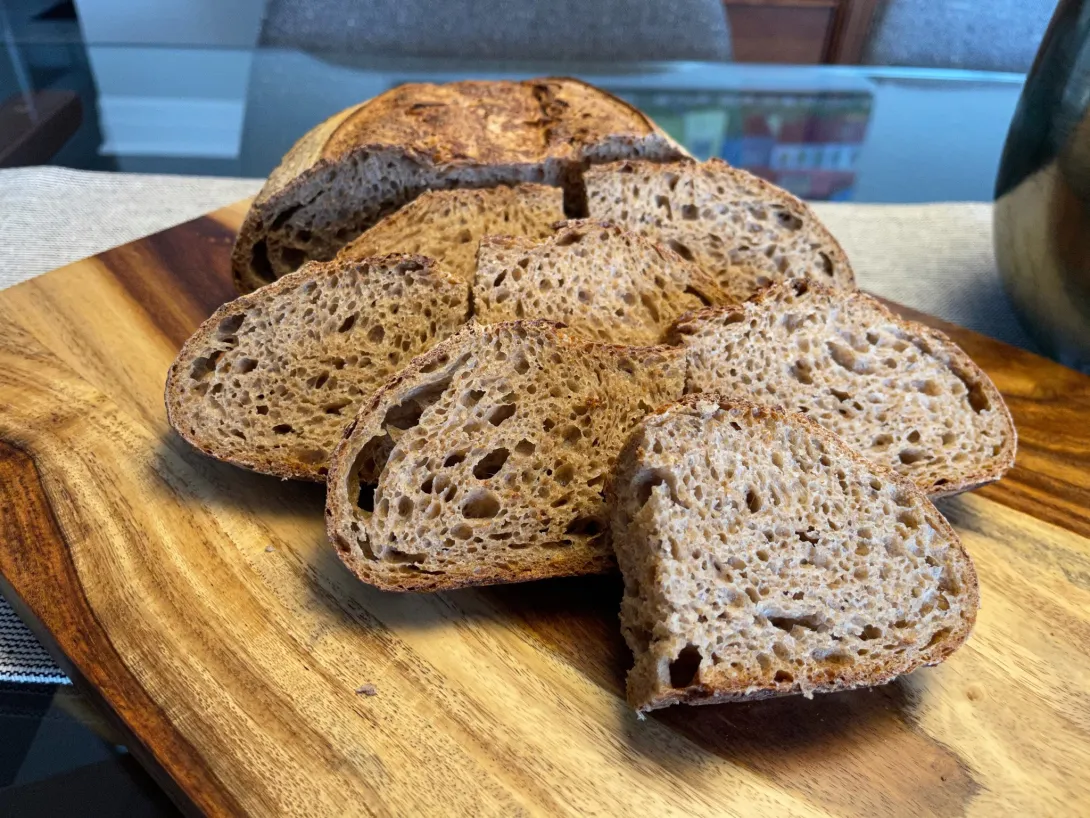
Image
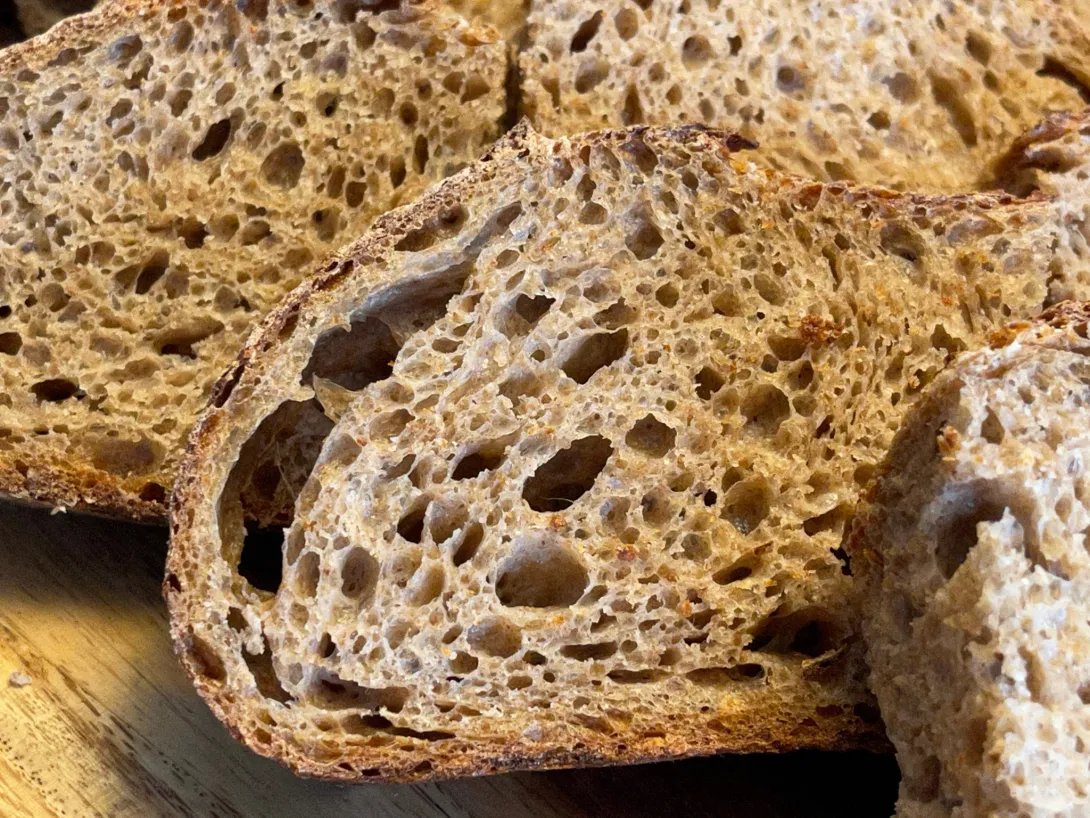
That looks like a nice slice of bread, but I know the sinking feeling of lifting a lid and seeing that the loaf doesn't have the outward appearance you expect. In my limited experience, and with my process, I've had limited oven spring with hydrations much above 75%, especially with the few older varieties of fresh milled whole grain wheat I've tried.
Well lowering the hydration is on the to do list for whenever I try this again. I was thinking of 76% but maybe I’ll go all the way down to 75%. The thing is, it is already quite dry when I do the mix at 80%. I guess to counteract that, I could do a stiff levain so I can add more water at the mix.